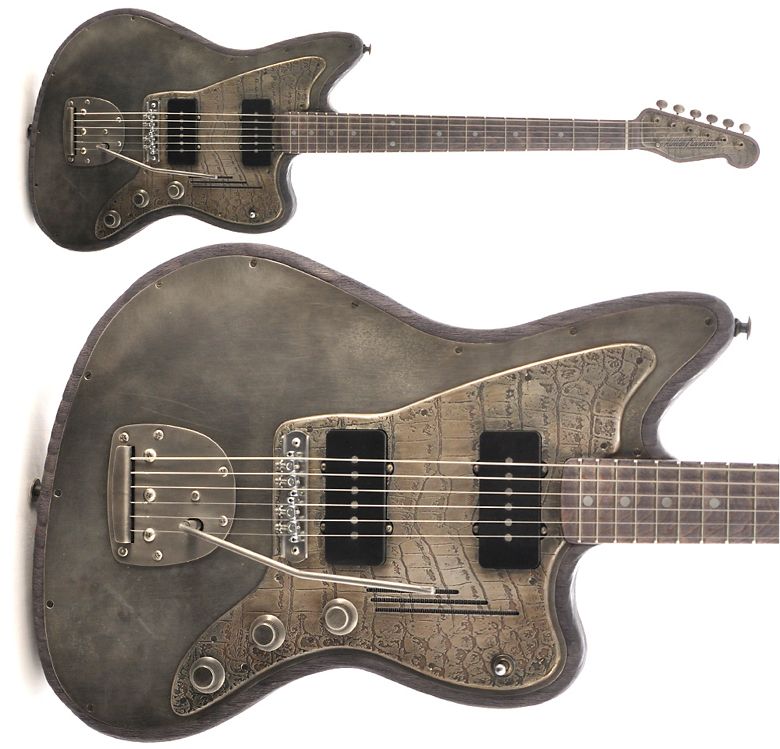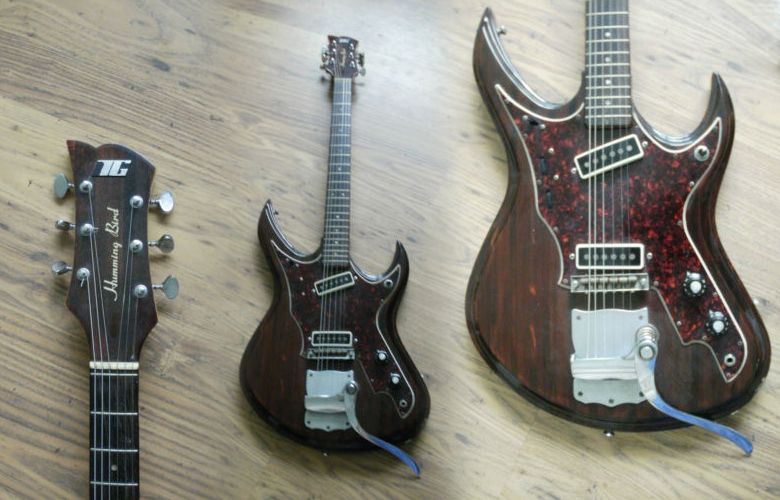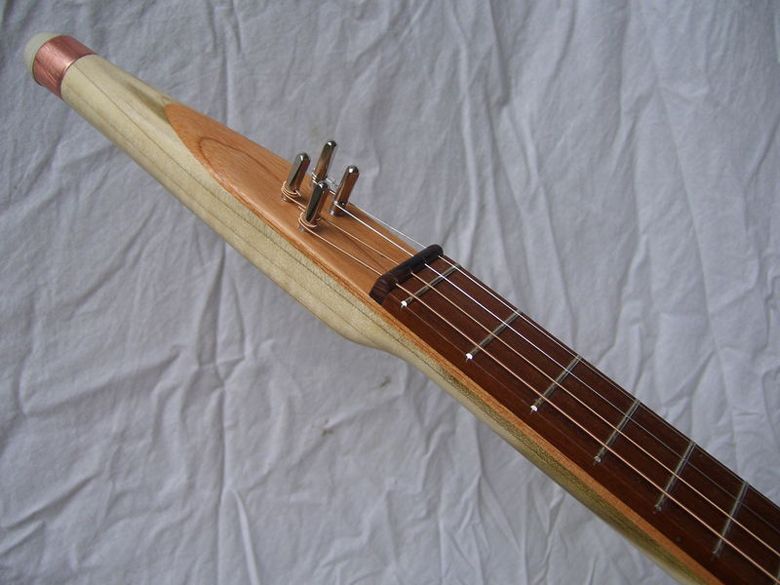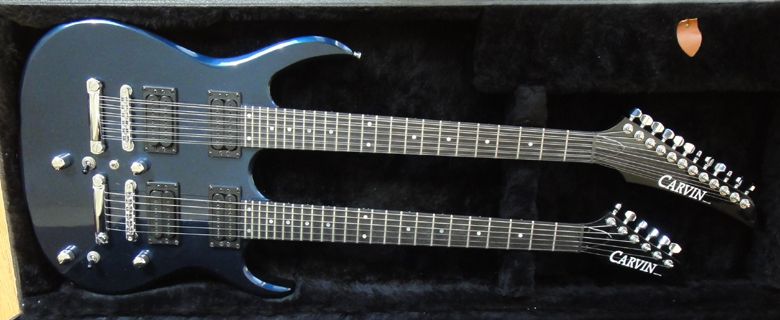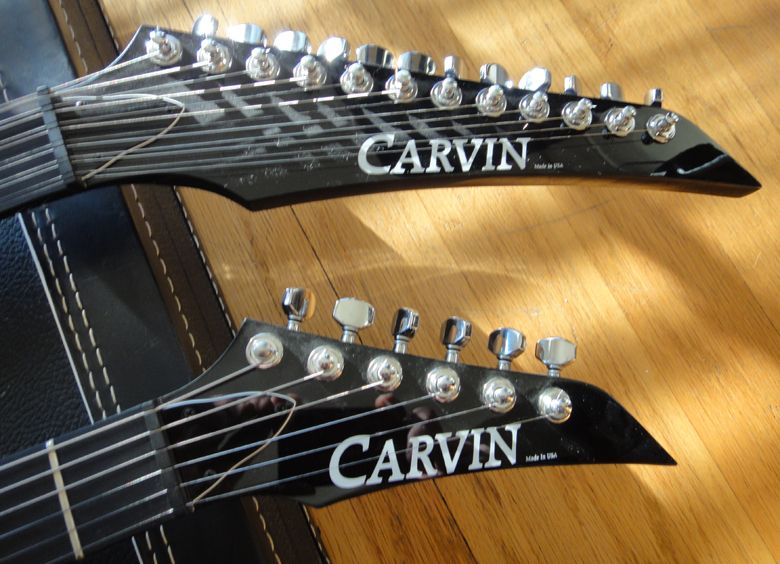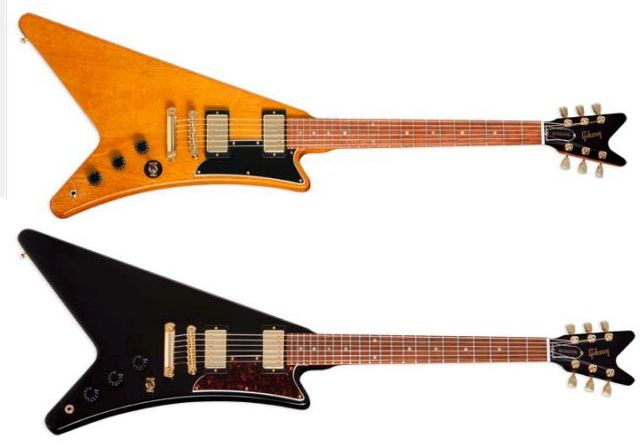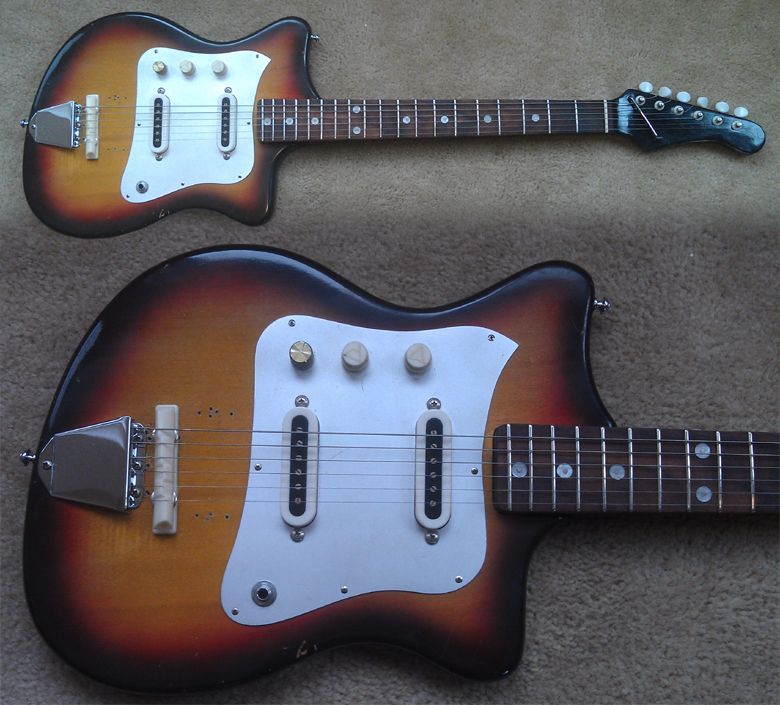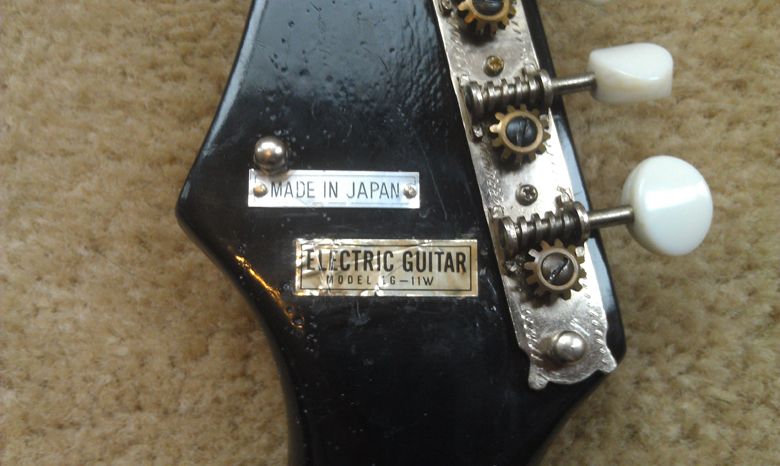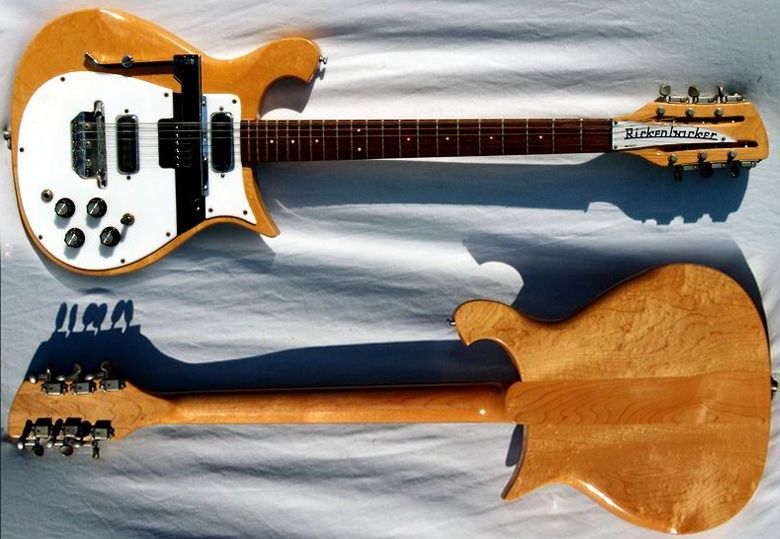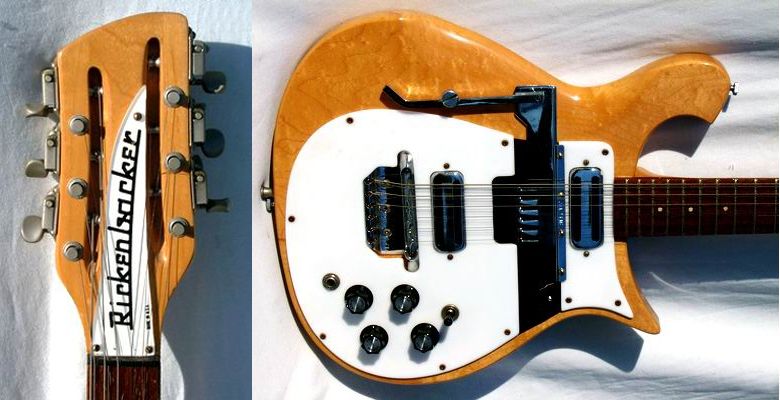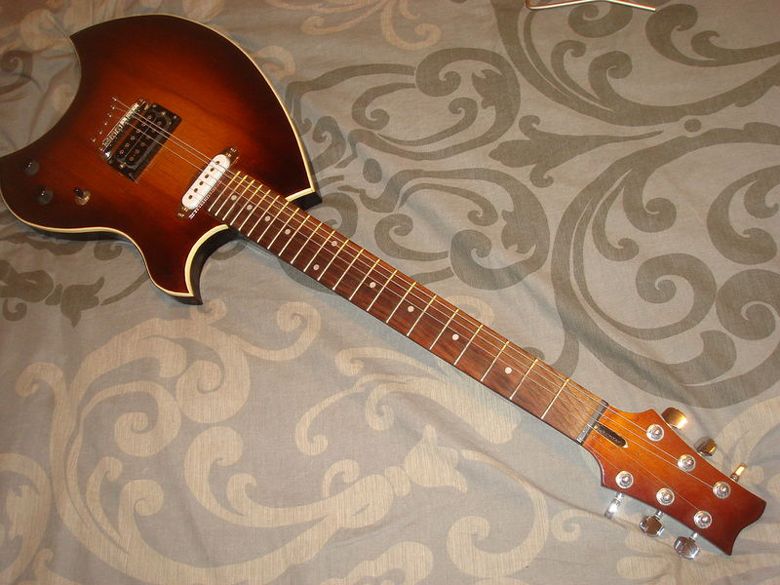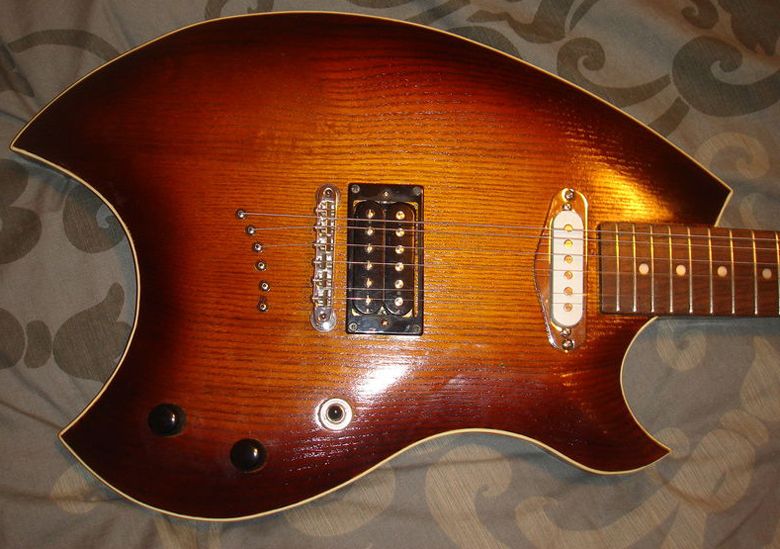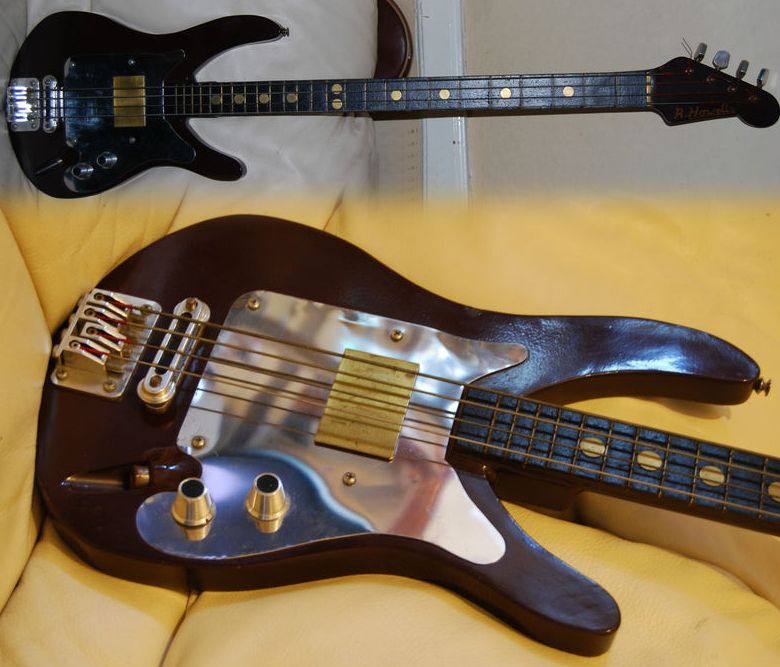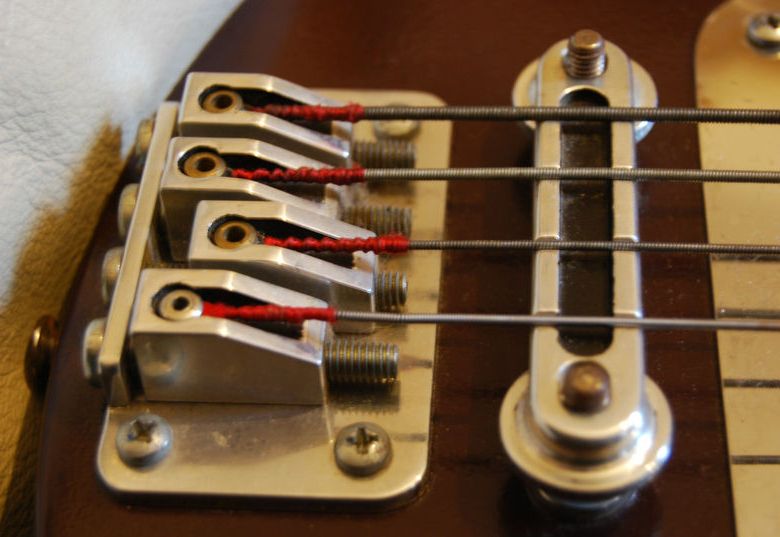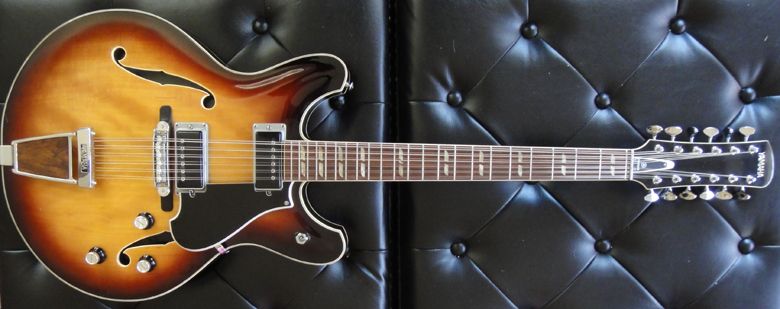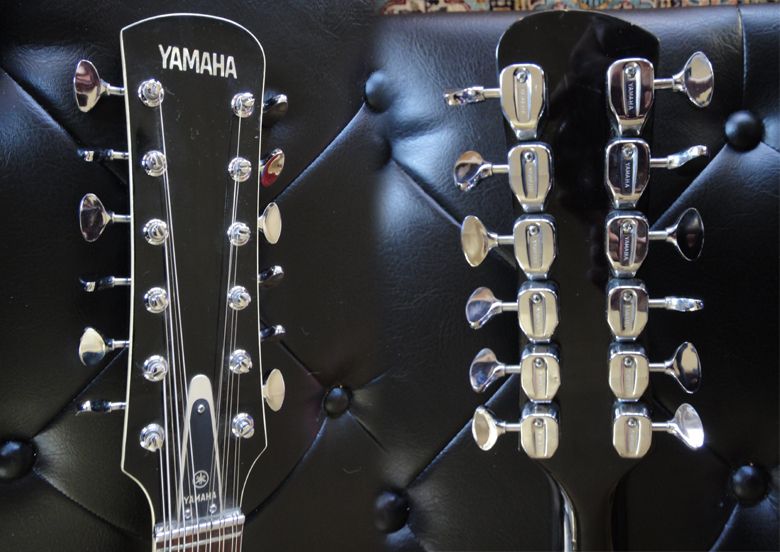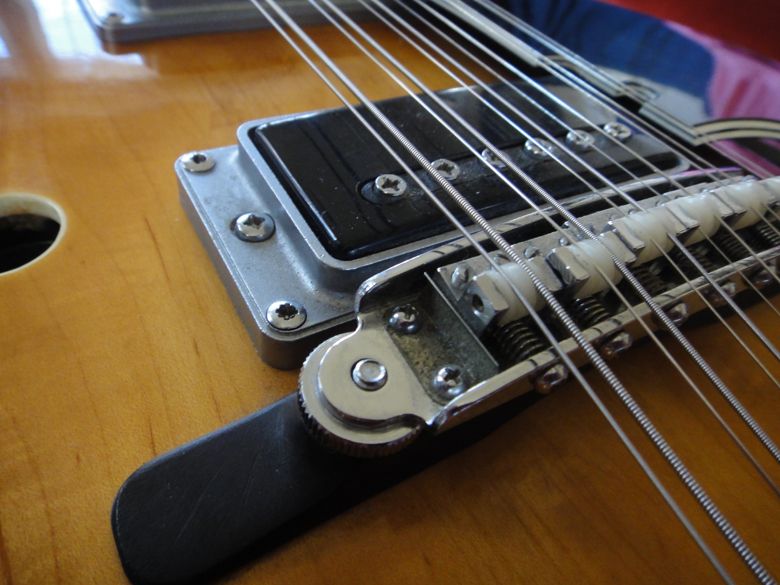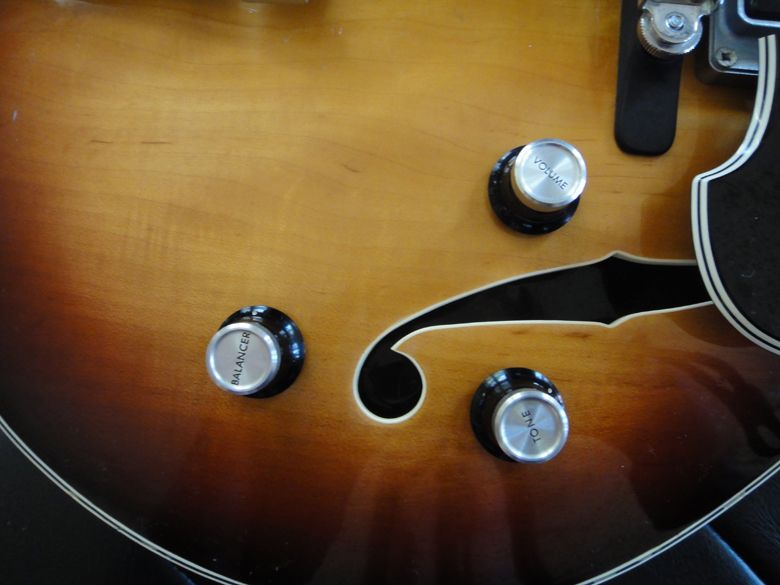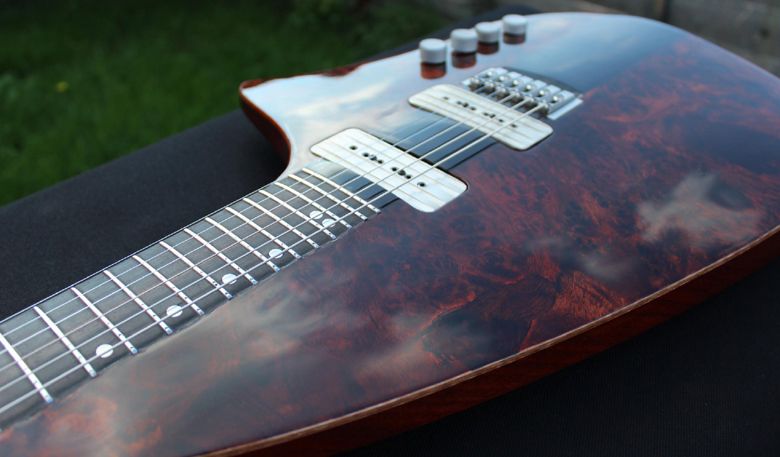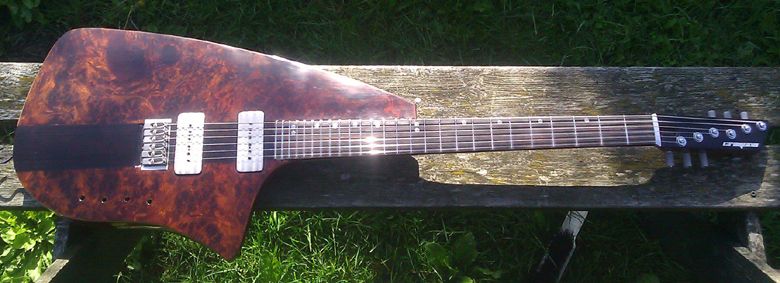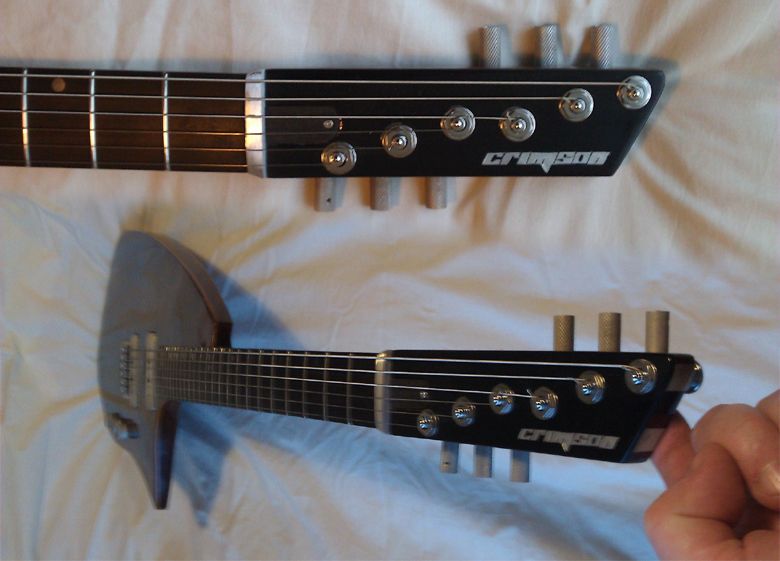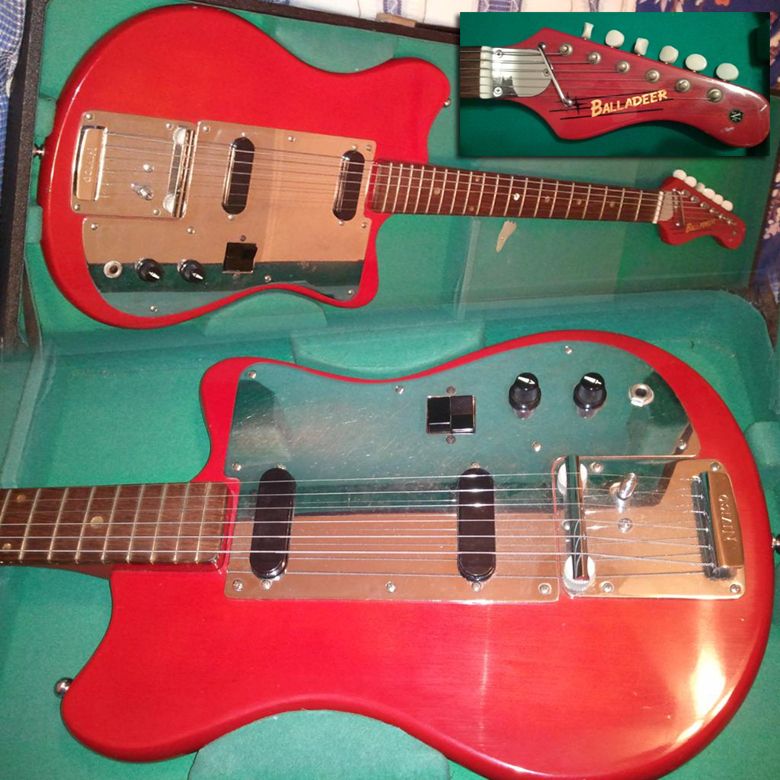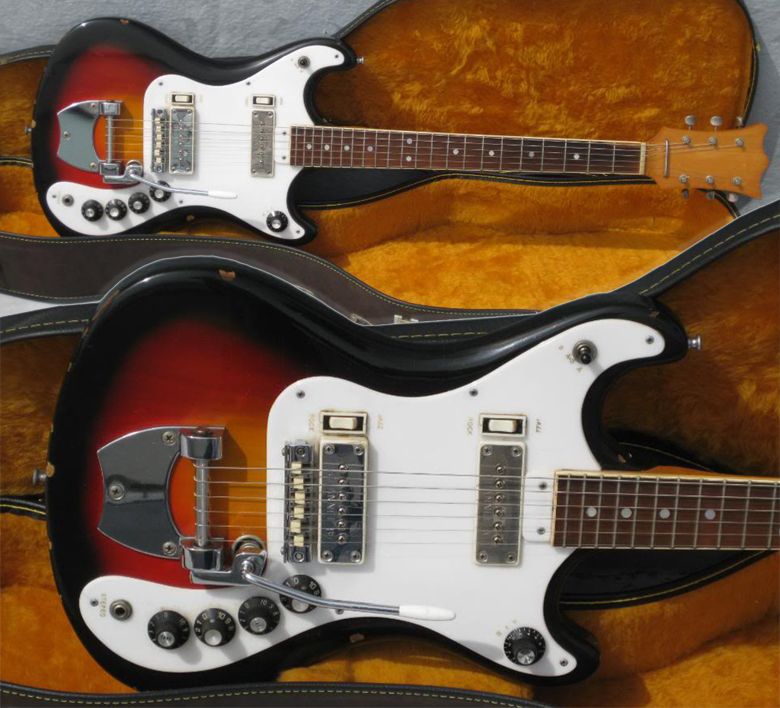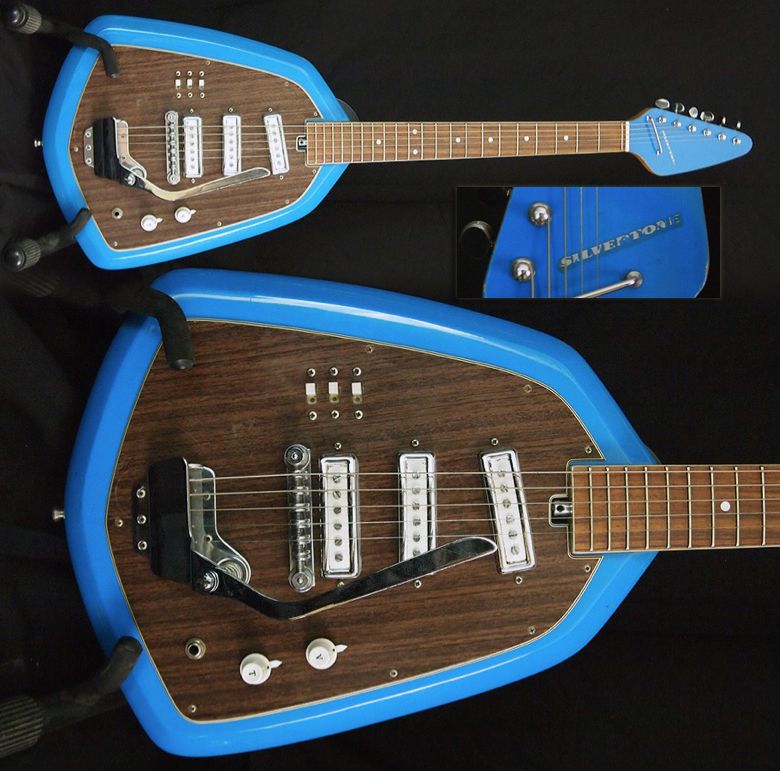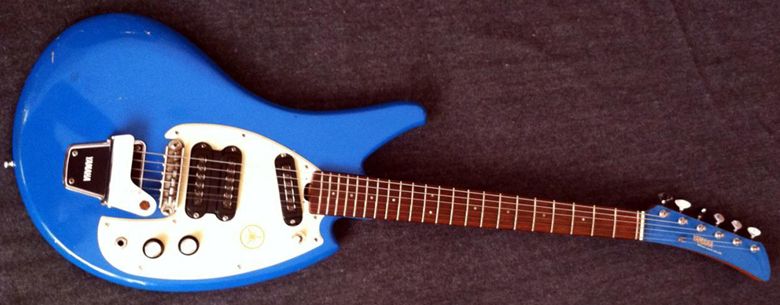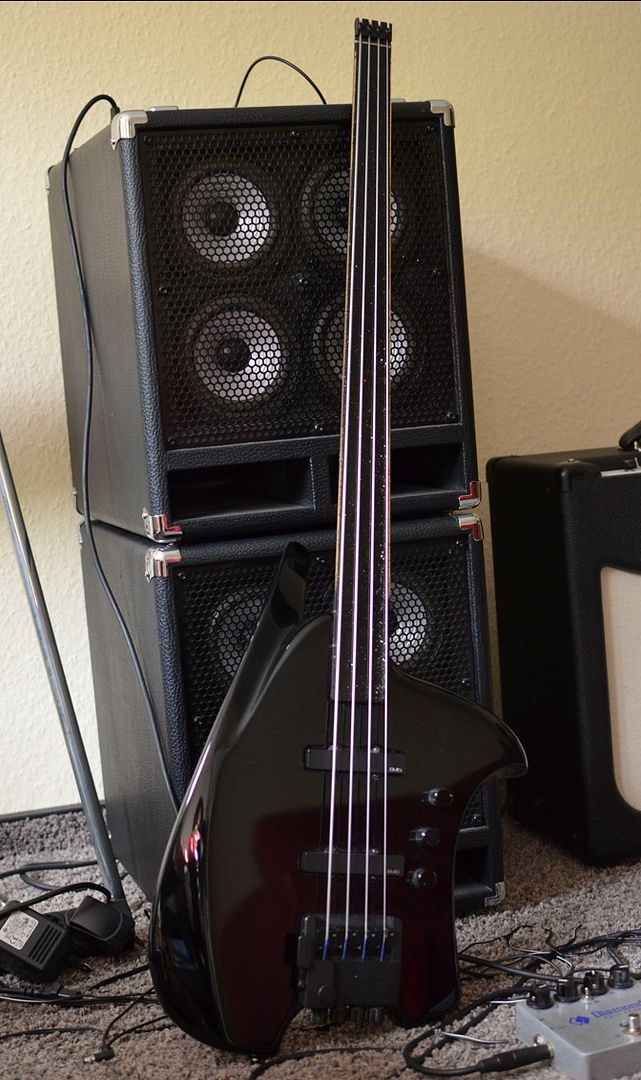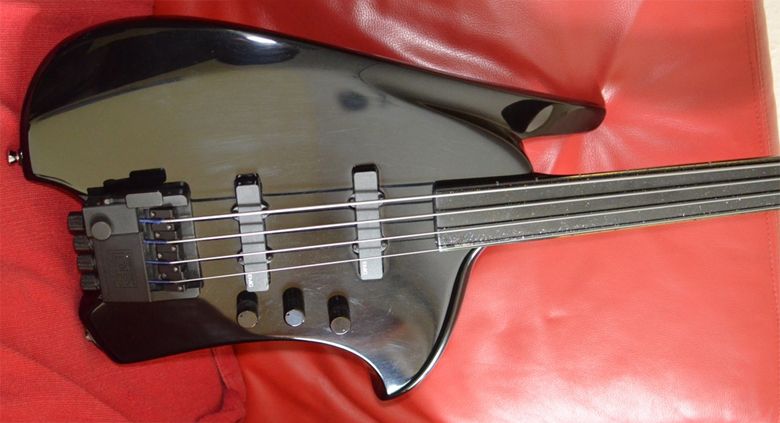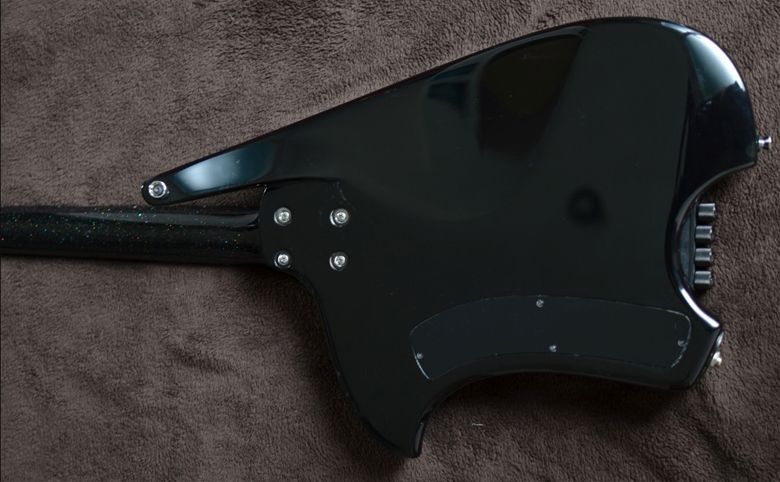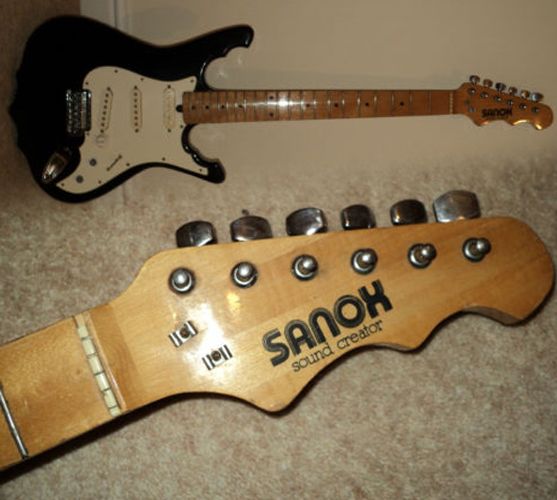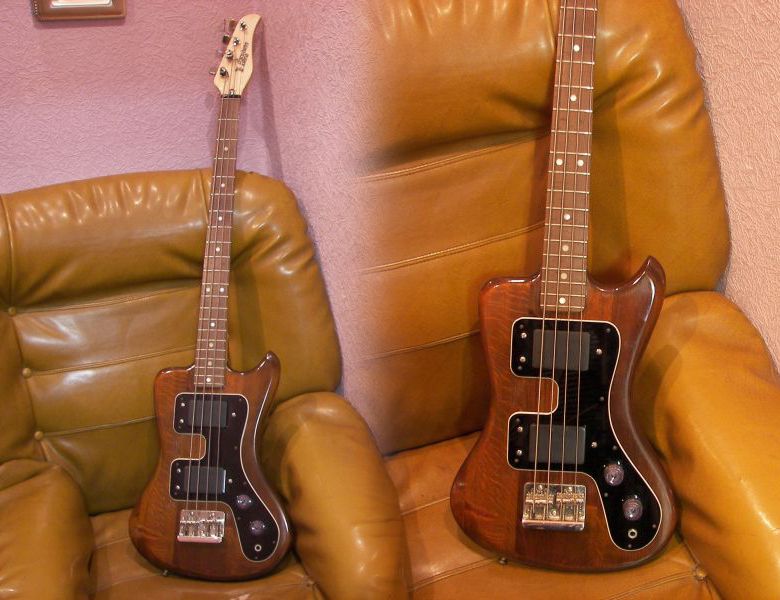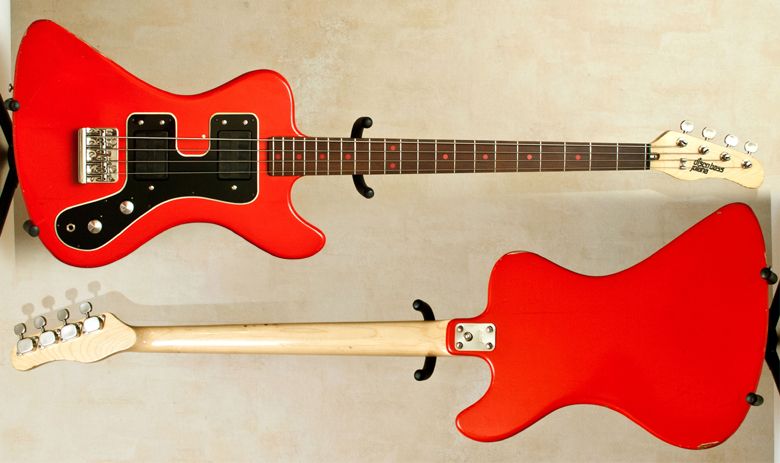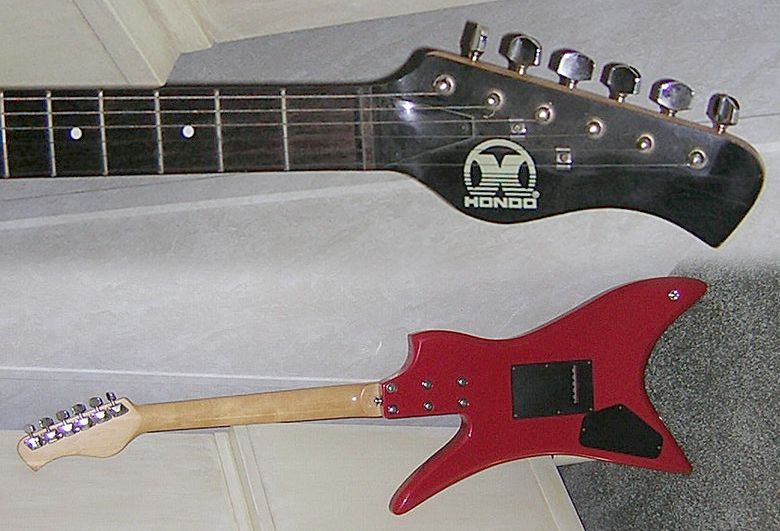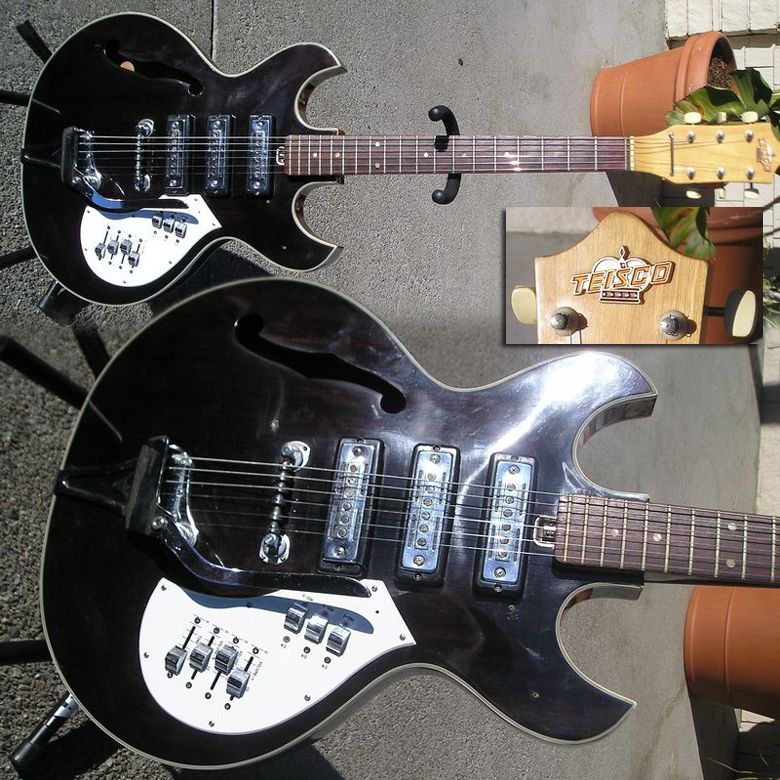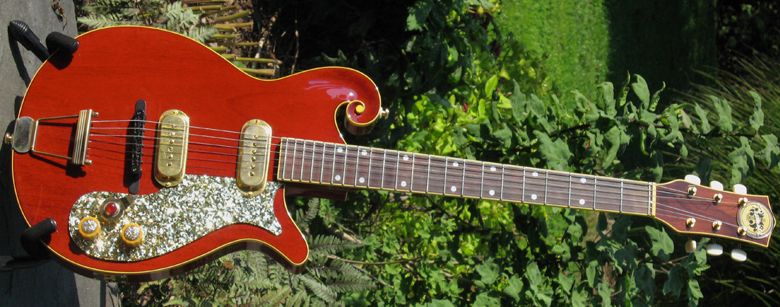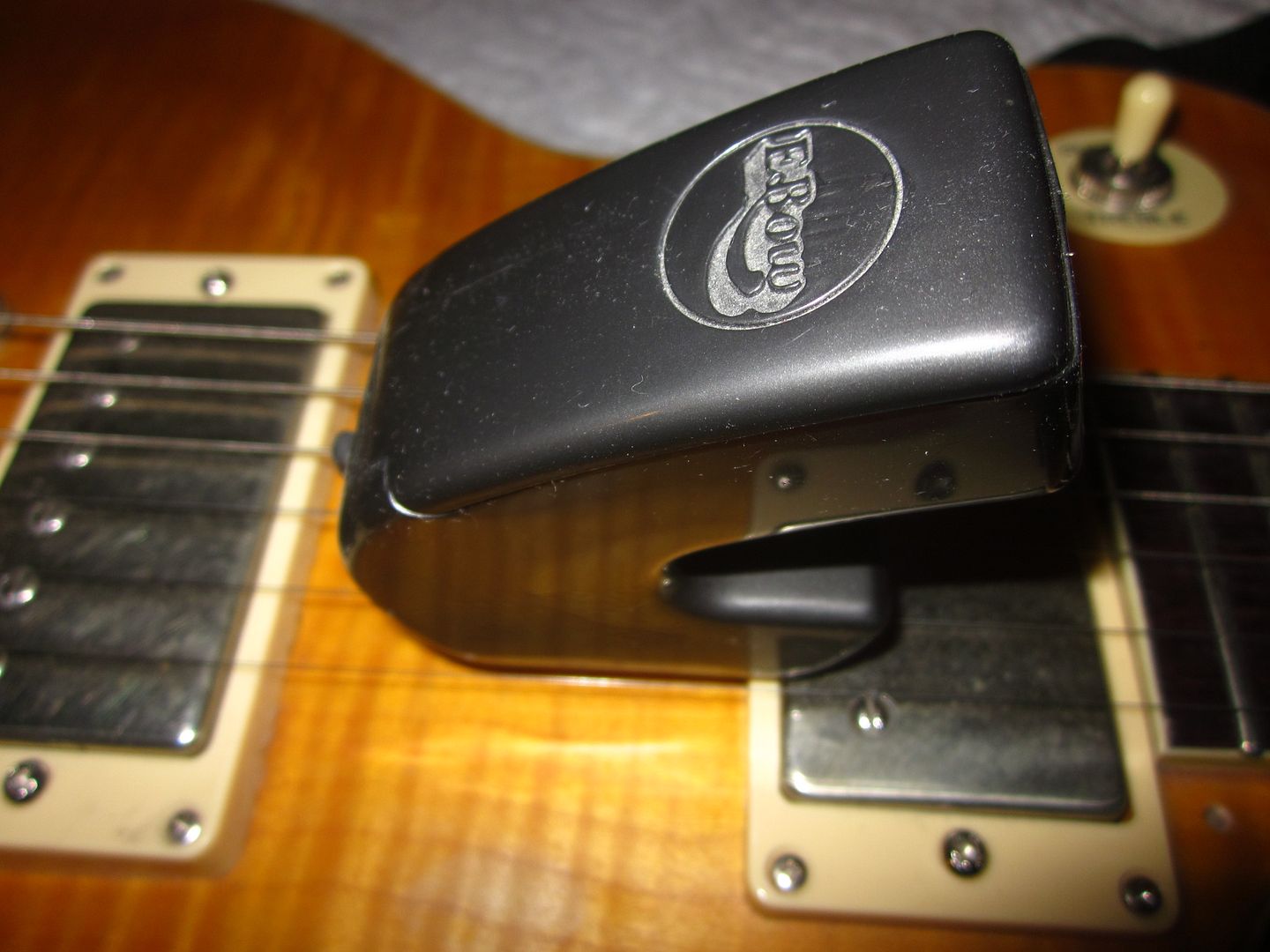Vintage & Rare guitar of the week: James Trussart Steelmaster
/
This guitar is currently for sale via Vintage & Rare, priced at €3185.
G L Wilson
© 2012, Guitarz - The Original Guitar Blog - now in its 10th year!
11:01 AM | Labels: cool guitars, Jaguar/Jazzmaster, James Trussart, metal front guitars
1968 vintage Tokai Humming Bird - cool Japanese-made rarity
/
The Humming Bird is a guitar of its age. It has the same generic pickups that we see on other Japanese guitars of the same era, plus a very basic sub-Bigsby vibrato arm. The body horns are quite pointed which again brings to mind various of its Japanese-made contemporaries (e.g. Yamaha's early solidbodies, the SG-2 and SG-3) and the body has some German carve contouring around the top edge. The front pickup is angled a la Mosrite guitars. (Mosrites were famously used by The Ventures, a band who were seriously BIG in Japan).
I admire the seller's honesty when he/she says that it is "not the best playing guitar ever made by far, but more of a desirable collectors item". There's no BS and no hyperbole, it's just telling it like it is, and I wish more eBayers would take a leaf out of this seller's book.
Likewise, the pricing is not out of this world. The starting price is £250 and the Buy It Now price is £375 (currently listed on eBay UK).
G L Wilson
© 2012, Guitarz - The Original Guitar Blog - now in its 10th year!
2:44 PM | Labels: cool guitars, Japanese guitar, Tokai, vintage
Tommy Emmanuel - 12 bar blues in the key of E
/
guitarz.blogspot.com:
It's the start of a brand new week, so here's a video to put a smile on your face and help cure those Monday morning blues:
Frank from the Lampeter Fire Station Guitar Club, which I've been attending recently, sent me this link. His comment was that it was "something to work on". Whoah, you mean that's this week's homework?
G L Wilson
© 2012, Guitarz - The Original Guitar Blog - now in its 10th year!
3:13 AM | Labels: acoustic, Tommy Emmanuel, video, YouTube
Walking cane tenor guitar/mandola - for those who like music on the move, now here's an instrument you can take hiking
/
A truly unique instrument, functions as a cane and a Tenor Guitar or 4 string Mandola at the same time. Tuned C-G-D-A, 19 inch scale, so it is a little long for a mandola, and on the short end of a tenor guitar scale, but in the cane design it is very ergonomic. The cane crook acts like a armrest, and it is very comfortable to play. Very light yet strong enough for support, the sound is not as full as a full-bodied instrument yet very sweet and clear. This is a fully acoustic Tenor Guitar, not a solid stick. It has a Spruce soundboard, Mahogany headstock lamination, Rosewood back and crook laminations. The body is hollow. The crook-cane handle is cross laminated for directional grain strength.The seller also makes walking cane mandolins, ukuleles and dulcimers.
G L Wilson
© 2012, Guitarz - The Original Guitar Blog - now in its 10th year!
10:13 AM | Labels: acoustic, hybrid instrument, Luthiers, mandola, one-offs, Tenor guitar
Carvin doubleneck - I wouldn't fancy tuning this up on a darkened stage
/
This is a early 90s Carvin doubleneck. It is, as far as I know, the only 6/12 that has the tuners on the 12 string neck inline. It makes for a very weird looking headstock... it looks more like a shovel.Thanks for showing us that beast, Derek. I can imagine I'd get into all sorts of tuning difficulties with a 12-string headstock like that. I often seem to go for the wrong tuner even on a regular 6-string 3+3 headstock. Still, in an on-stage situation, I guess that's what guitar techs are for.
It appears to be the same as the guitar on this catalog page from 1990.
The 12 inline was a option, the 6+6 was standard. The microswitch is the neck selector.
It's very heavy. The neck feels like a cross between an Ibanez RG and a Jackson; it's very thin, flat and wide. It is very much in keeping with the Superstrat/shred guitar design (other than the lack of a Kahler or Floyd). It's well made just like any other Carvin I've run across, but offers little in the way of new ideas. It looks and feels very late 80s if that makes sense.
G L Wilson
© 2012, Guitarz - The Original Guitar Blog - now in its 10th year!
3:16 AM | Labels: 12-string, Carvin, doubleneck, superstrat, Your Guitars
Gibson Moderne - "reissue" of a classic guitar that probably never existed in the first place
/
guitarz.blogspot.com - Guest blog by Steven Williams of www.dawsons.co.uk:
© 2012, Guitarz - The Original Guitar Blog - now in its 10th year!
12:00 AM | Labels: Gibson, guest blogger, News item, Product news
Gus G1 baritone guitar - carbon fibre, aluminium tube, flip flop paint, and 001 serial number
/
This particular example is a Gus G1 Baritone guitar with the serial number G1/B 001. Built by Simon Farmer in the UK, each Gus guitar or bass is essentially a custom order, although some instruments will have more specific custom features than others. The construction is of cedar with a skin of carbon fibre. All hardware is fabricated in-house a the Gus workshop so these guitars are not going to carry all the same generic hardware that we see everywhere else. The body is basically a teardrop shape and - most notably - is mounted inside a chrome-plated aluminium tube (actually welded in 5 sections). This tube helps give the instrument a more recognisable guitar-like shape and provides the familiar body horns.
The G1 Baritone has a 30" scale length and is designed to be tuned down to B (a fourth below 'normal' guitar pitch). This example has been finished in "Plum Crazy" purple to green flip flop paint from House of Colors.
For more information please check out the Gus Guitars website.
Currently listed on eBay UK with a starting price of £2999.
Thanks to Dirk for suggesting we feature this guitar.
G L Wilson
© 2012, Guitarz - The Original Guitar Blog - now in its 10th year!
4:17 AM | Labels: baritone guitar, British guitars, carbon fibre, Gus Guitars, Luthiers, unusual materials
Homemade one-string bass guitar with fretless aluminium fingerboard
/
Thanks to Jeremiah for bringing this auction to my attention. He comments that, with a starting bid of $9.99, at least the price is fair.
G L Wilson
© 2012, Guitarz - The Original Guitar Blog - now in its 10th year!
1:00 AM | Labels: bass, fretless, handmade, minimalist guitars, one-offs, weird customisations, Weird guitars
Guyatone LG-11W - another forgotten 1960s Japanese guitar
/
I recently saw your post about the JVC Balladeer and I was surprised to see that I have a Guyatone in this (I think) same body/headstock design. The major difference is the pickguard configuration and it is certainly of a lower level model with no tremolo system. The pickguard is still of metal construction, just a flat finish and the controls on top of the pickups, which is actually quite comfortable. I have looked and looked all over the web and I've yet to see any Kawai/Teisco/Guyatone Japanese guitars with this same exact body design.Here's a YouTube video of Joshua demoing the guitar. It just goes to show there's life in some of those old Japanese "pawn shop" guitars, although some of them might need some resuscitation.
It has model number of LG-11W, which falls in line with Guyatone model numbers and of course has a 'Made in Japan' sticker, but unfortunately it no longer has its headstock badge (just a sticky residue of where one used to live).
In fact, I'm in the middle of refurbishing the neck and fingerboard due to too much lovin'! This thing was played to death and I'm certain whoever attempted to refret the fingerboard was not a pro, as there where large chips in the dried out rosewood. I decided to refinish the black neck paint while I was at it, which showed large stress cracks through the finish. I'm by no means a "pro" luthier, but I am an inspiring luthier who has made his own guitars. And as some may think this is sacrilege, I've decided to turn this 24.5" scale into a 25.5" scale and move the bridge/tail back that extra inch. I liked the feel of 24.5" but it was way too narrow for my liking. If I had any intention of selling the guitar, I would have of course kept it to its original scale.
Joshua
We're always happy to see readers' guitars - the more interesting or unusual the model, the better - so please do keep sending in your photos and stories. Contrary to widely held belief, we at Guitarz can appreciate a nice Strat, Tele, Les Paul or SG the same as the next man, woman or dog; however, I think all our readers already know what they look like and what they can do, so we would prefer to see something just a little bit different from the run-of-the-mill guitars you see everywhere. Having said that, if you do have a Strat, Tele, Les Paul, SG, etc, with a particular story to tell, or an unusual variant or finish, then we wouldn't rule out including it on the blog.
G L Wilson
© 2012, Guitarz - The Original Guitar Blog - now in its 10th year!
9:14 AM | Labels: Guyatone, Japanese guitar, vintage guitars, vintage modification, Your Guitars
Vintage & Rare guitar of the week: 1968 Rickenbacker 456 6/12 Convertible
/
Looks aside, you have to wonder why a contraption such as this wasn't more successful and why it didn't spawn much imitation. It must surely be a much more convenient way of switching between 12-string and 6-string guitar than using an unwieldy and back-breaking doubleneck guitar. Maybe I have just answered my own implied question, as the Rickenbacker Convertible lacks the visual impact and sheer stage presence of a doubleneck. I guess that rock'n'roll isn't all about the most sensible way of doing something.
This particular Rickenbacker 456 6/12 Convertible is from 1968, is finished in "Mapleglo", and is currently available for sale via Vintage and Rare with a price of €2800.
G L Wilson
© 2012, Guitarz - The Original Guitar Blog - now in its 10th year!
7:11 AM | Labels: 12-string, hybrid guitar, innovations, Rickenbacker, Vintage and Rare, vintage guitars
One-off Breadwinner-inspired project guitar
/
The seller doesn't tell us a great deal about it; the body is ash, the set neck is mahogany and it has a Strat-like singlecoil in the neck pickup position and an Epiphone humbucker at the bridge. Oh, and it was built by the seller's mate Tony from the Swamp Rats.
Currently listed on eBay UK with two days left to run on the auction and bidding currently at £41 at the time of writing.
G L Wilson
© 2012, Guitarz - The Original Guitar Blog - now in its 10th year!
6:01 AM | Labels: breadwinner, ergonomic guitars, handmade, one-offs
R. Howells one-off metal bass guitar - one for the scrap heap, perhaps?
/
But another part of me wants to scream, "No no, it's all wrong!" The neck looks exceedingly long, but perhaps that's because the body is small. It may be my imagination, or else the angle of the photograph, but in the full length picture it looks as if the neck is wider up at the nut than it is at the body end. I suspect that it is actually parallel along its length, which would be unusual but not unusable. Of course, playability would all depend on how it intonates. Are the frets positioned correctly for the scale length? They may be, but the cynic in me thinks that this is unlikely.
Look at the engineering of the tuners which are integral to the headstock. I have to wonder if this perhaps was a project by maybe an apprentice metalworker. A certain R. Howells, most likely!
Down at the other end of the bass we find a very solid piece of hardware with adjustable retainers for each string. Quite what purpose these are supposed to serve, I do not know, for they are behind the bridge - which itself does not seem to have saddles of any kind. Maybe the tailpiece blocks are intended as fine tuners, but this does seem a weird inclusion where adjustable saddles would be considerably more useful.
The angled jack on the face of the bass is a nice touch, as are the hand-turned contol knobs, but this bass has not been wired up nor has it been finished having only a dummy pickup mounted in its aluminium pickguard. (And considering the detailed metalwork elsewhere, why does the pickguard look so crudely cut out? Was it finished in a hurry, perhaps?)
This would probably make a better sculpture than a working bass guitar. A lot of hard work has obviously gone into it, so it's only a pity that it resembles a child's drawing of an electric guitar.
Currently listed on eBay with a starting price of £100.
G L Wilson
© 2012, Guitarz - The Original Guitar Blog - now in its 10th year!
3:42 AM | Labels: bass, handmade, Hideous guitars, Metal body, Metal neck, one-offs, Weird guitars
Yamaha SA-20 semi-hollowbody 12-string electric guitar from 1968
/
Having shown the Yamaha SA-30, I thought you might be interested in this 1968 SA-20; it's the same guitar (minus vibrato) as a twelve string. The price in 1968 was $315 according to a catalog you can view here, making it the most expensive of the SA (semi acoustic) line at the time, about $2000 in today's dollars.Thank you, Derek, for sharing this with us. Perhaps one day I'll get my mitts on a similar guitar!
When I first got the guitar, I noticed that there's black plastic inside the F-holes; this, I learned from the catalog, is a baffle intended to suppress feedback (patent pending!). If you've both pickups selected the "mic balancer" lets you blend between the two; the pickups are the size of humbuckers but I think they are single coils. Either way, they're attractively fitted. The neck is very narrow, and the nut (which I don't believe to be original) makes it challenging to play; but overall the workmanship is superb.
In that same catalog is a very interesting amplifier, the TA-60; I'm including a picture of that as well. I'd really like to find one to compliment the guitar.
Best Regards,
Derek
G L Wilson
© 2012, Guitarz - The Original Guitar Blog - now in its 10th year!
3:23 AM | Labels: 12-string, cool guitars, Semi Acoustic, semi-hollow body, vintage guitars, Yamaha, Your Guitars
Crimson Guitars Delta 1 - an ergonomically-designed bespoke guitar from the UK
/
For anyone with even a passing interest in how a guitar is built, I cannot recommend the workshop diaries highly enough: they provide a fascinating - and never boring - blow-by-blow account of each and every aspect. They also show Ben Crowe to be a fastidious luthier; he really is a perfectionist and will insist on getting every last tiny detail absolutely right. As well as building complete guitars by hand from all manner of beautiful timbers - and occasionally he's carved guitars from acrylic too - Ben will also often create the hardware - bridges, tremolos, tuners, control knobs - by hand in the Crimson Guitars workshop rather than using generic off-the-shelf components. Ben is also a keen advocate of ergonomic guitars. Even his classic-looking Robert Fripp model single cutaway guitars (yes, Robert Fripp is an endorsee) have beautifully carved rear-sides, all in the name of comfort! You don't get that on a Les Paul!
The guitar pictured here, the Delta 1, is - as you may surmise from the shape - an ergonomic design. It was the brainchild of the customer, James Mitchell, who worked with Ben Crowe in the Crimson Guitars workshop upon his own design in the early stages of the guitar build, leaving Ben to complete and finish the instrument when he had to return home.
I asked James if he could tell me what his original brief for the Delta 1 was, and the general concept behind it. James kindly replied, in detail, as follows:
I have always had a 70s Strat which I love and I had never really owned or played anything else. A work colleague, Kevin Deane, makes guitars just for himself for the look and the pleasure. So it got me thinking, why have another Strat or Les Paul? I had recently come into a few guitars which all had features I really liked but none had everything. So, as an architect, I couldn't resist but doodle. There is a tendency for custom guitars to be over-wrought or gilded lilies in my view. I wanted something purposeful, sleek and unique to me.
I overlaid pictures of guitars I enjoyed playing and made hand sketches combining the elements, from each marque, that felt best to me. I then started to read a bit about construction and tone. Around this time, I went to London for Chapman Stick lessons. Out of that, came a conversation with Paul Davies of Tollbooth Studios, who said there was this guy who would build anything. I had approached other builders and they kept re-interpreting the design back towards a known design and would put it together from stock parts. Now, even I can bolt bits together, so I was underwhelmed. The other path of a bespoke instrument prototype was looking very very costly.
The key features of my design where to keep it simple and incorporate:I liked the tuners on a Japanese shamisen and thought something like that could be achieved. Ben turned bespoke parts for the Sperzels.
- A longer scale length for tone and I am 6'6'' so something at my scale. Les Pauls are mandolins to me and my chubby fingers have trouble above fret 15.
- Through neck construction for tone transfer.
- Tight radius fretboard at nut and 700mm radius at the intonation point, reflecting my strat but slightly flattened like a Parker.
- A "D" neck profile.
- Quite a bit of body beyond the bridge for my arm, balance and as a tone reservoir.
- Flush neck and body with same radii.
- Parkeresque slimness.
- Full 24 fret access like a Stick.
- A tone transfer bar reaching up to twelth fret, like a Skjold bass.
- A headstock without fripperies, like a Seagull guitar but less shapely. I considered headless but it seemed counter intuitive to me.
These disparate thoughts were worked through in sketches and 5 or 6 full size blanks from polystyrene and filler. I then made the final sketch, measured drawings and a 3D-rendered computer model and sent these to Ben as a brief.
We kicked the details around for three months exploring ideas for a full contact tremolo, woods, frets, pickups etc. In the end it worked out I could go meet Ben and stay for two weeks to develop the build with him. I don't think it could have been done remotely really because the dialogue between us was very dynamic and fruitful. I had a good grasp of what I wanted but Ben brought the reality and craftsmanship to examine, interpret and realise my thoughts, to create the final guitar. Working on the guitar with Ben also allowed me to see other possibilities. This was so successful I have asked Ben to make a semi-acoustic version. This time he knows where it's headed and I await something based on Delta 1 yet distinctly different.
Some have pointed out it is Teufell Tesla-esque, which I take as a compliment, considering it's my first design. It owes more to the Chapman Stick, Breadwinner and Parker/Strat. The controls have evolved since I have had the guitar to play. Andy at Wizard Pickups made 2 bespoke match P90s to work with Ben's stunning bespoke pickup covers and not produce hum. I have fitted 2 volume pots, 1 tone pot and a blender. The guitar produces a lot of rich tones and the blender allows me to exploit the all the gradients of tone between bridge and neck.
I would say that this is where Ben's unique selling point lies. With so much CNC'd or assembled from parts suppliers it's a precious thing to find someone who will start from scratch. Ben buys and selects timbers just for the instrument qualities you specify. The construction then is further informed by his knowledge and your aspirations. Start off with an idea, informed as best it can be from a player's perspective, then brought to reality through real craftsmanship. Exciting and the result is an instrument that is everything I wanted it to be and having other characteristics that couldn't be known. So now I have something to play and explore with.
I have been asking proper guitarists to try it out, mainly at my local music store, KnB Music Maynooth. So far, very positive results. Some are freaked by the shape or the flush neck and body. But once they have 5 minutes playing that all fades away and the balance, playability, comfort and the tone come through.
For even more details, check out these YouTube videos produced by Crimson Guitars:
I would like to thank both Ben Crowe of Crimson Guitars and James Mitchell for their cooperation and help in producing this blog post.
For more information, see Crimson Guitars - bookmark it and visit often!
G L Wilson
© 2012, Guitarz - The Original Guitar Blog - now in its 10th year!
1:39 AM | Labels: British guitars, cool guitars, Crimson Guitars, ergonomic guitars, handmade, Luthiers, one-offs, video, Your Guitars, YouTube
JVC Nivico Balladeer Electric Guitar model #SG-16 - another Japanese oddity
/
Here's how the seller describes the guitar:
Up for auction is a vintage JVC Nivico Balladeer Electric Guitar (model #SG-16) which appears to originally be intended only for Japanese distribution but has mysteriously been re-branded for US sales. Information on this guitar is conspicuously absent from the internet (a feat in itself) but in-depth research has shown that these guitars, along with a related deluxe model and electric amplifiers, were marketed alongside Japanese "eleki" beat groups (http://www.geocities.jp/a104gs/jvc.nivico.html). This, along side its extreme rarity, support the idea that this guitar was either not intended for distribution outside of Japan or is part of a very early attempt to market Japanese guitars in America. Despite the intial similarities one might find between this guitar and the dirge of Japanese guitars that were soon to flood the US market, such as a surplus of chrome and an overall amoeba-like shape, this guitar has appointments that one does not find on any other Japanese import. Not to mention it plays better than any other Japanese guitar from this era that I have ever laid hands on, weighs twice as much, and has an attention to detail that surpass as well.It does have a Kawai/Guyatone look to it, but I can't find another guitar that is similar enough to make the comparison with more conviction. It's an interesting guitar for sure, if a bit of an ugly duckling.
This guitar is currently listed on eBay with a quite reasonable Buy It Now price of $400.
By the way, for those interested in Japanese "eleki" music and the development of rock music in Japan, I would heartily recommend the book Japrocksampler by Julian Cope.
G L Wilson
© 2012, Guitarz - The Original Guitar Blog - now in its 10th year!
3:44 AM | Labels: cool guitars, Japanese guitar, JVC, vintage guitars
Alray Cougar vintage stereo guitar - a Wurlitzer in all but name
/
However, if you look closely at the Cougar pictured above you'll notice one or two differences from the example we previously featured. The headstock design is quite different, and notice also that the vibrato base plate is missing its Wurlitzer "W" - in fact this vibrato unit looks identical to that employed on the LaBaye six stringer.
The reason behind this is that this particular Cougar is not a Wurlitzer - it instead carried the Alray brandname. From the information I have gathered, Wurlitzer offered the Wild One series guitars from 1965 to 1966. The seller of this Alray Cougar on eBay suggests that this guitar is circa 1967/68. Maybe this was assembled from left-over Wurlitzer stock after they had decided to abandon their guitar line?
This guitar is currently being offered for sale on eBay with a Buy It Now price of $1,200, which is in a similar price bracket to Wurlitzer-branded guitars (if and when they come up for sale).
G L Wilson
© 2012, Guitarz - The Original Guitar Blog - now in its 10th year!
6:48 AM | Labels: Alray, cool guitars, Stereo guitars, vintage guitars, Wurlitzer
1960s Silvertone "Phantom"-inspired guitar
/
As with anything stamped "Silvertone", you can guarantee this is another manufacturer's guitar, re-badged. It has a Domino look to it, although I don't think I've seen a Domino of quite the same design. The neck bolt plate confirms that this guitar is "Made in Japan".
This guitar is currently listed on eBay with what I'd call a slightly optimistic Buy It Now price of $975.
G L Wilson
© 2012, Guitarz - The Original Guitar Blog - now in its 10th year!
8:43 AM | Labels: Domino, Japanese guitar, optimistic sellers, Silvertone, vintage guitars, Vox
Rare 1967 Yamaha SG3C "Blue Banana" on eBay Australia
/
"Does anyone out there have one of these they would be willing to make a full size tracing of the body for me?"Which seems a fair enough request. Please respond via the comments below and I'll see to it that Greg gets your message.
The Yamaha SG3C is indeed a cool guitar, and was introduced a year after my own beloved Yamaha SG3 (similar model number, very different design), about which I have written plenty already. Both guitars have the same three singlecoil pickups arranged with one coil at the neck and two in the bridge position. However, the SG3C adopts a much simpler switching system than its slightly older sibling's Jazzmaster-like setup and functions only as a two pickup guitar with the two coils at the bridge being wired together in series. For those who are interested this video gives quite a nice little tour around the insides of the guitar.
This guitar is currently listed on eBay Australia, with five days left to run on the auction and bidding currently at just under AU$300 (Australian dollars) at the time of writing.
G L Wilson
© 2012, Guitarz - The Original Guitar Blog - now in its 10th year!
4:09 AM | Labels: cool guitars, Japanese guitar, vintage guitars, Yamaha
Vintage & Rare guitar of the week: Klein fretless ergonomic bass
/
We were discussing ergonomic guitars recently, and of course the name Klein came up.
Steve Klein mainly builds high-end acoustic guitars these days, but he is probably best known for his ergonomically designed headless guitars. We at Guitarz have previously featured a rare left-handed example of the Klein BF-96. These guitars are no longer in production, but have inspired numerous luthier-built instruments and ergonomic self-build projects.
I had heard that Klein produced a bass, but had never seen an example before I was browsing Vintage and Rare this weekend. You'll notice that the body is slightly more elongated than the guitar model, and it also has an upper body horn, which no doubt helps achieve the correct balance of the bass on a strap.
The specifications are as follows:
- 34" Scale
- Fretless Moses Graphite Neck
- Alder Body
- Active EMG J-Pickups
- Passive Electronics
- Steinberger D-Tuner Bridge
- Uses standard strings
- Refinished Body (Nitro)
- Volume - Volume - Tone
This very rare Klein fretless bass is currently available for sale via our good friends at Vintage & Rare and is priced at €6800.
G L Wilson
© 2012, Guitarz - The Original Guitar Blog - now in its 10th year!
9:11 AM | Labels: bass, ergonomic guitars, fretless, headless, innovations, Klein, unusual materials, Vintage and Rare
The Association - Along Comes Mary (but what are the guitars?)
/
guitarz.blogspot.com:
Via the Guitarz Facebook page our friend Jarma asks what are the guitars being played by The Association in this 1960s TV performance.
Well, the bass is easy: it's a Gibson EB-2 semi-hollowbody bass. Initially I wasn't too sure what the rhythm guitar was, so I moved onto the solidbody lead guitar as I was sure we had featured one very much like it here on Guitarz. Sure enough, it's a Hagström Impala, and that made me think that perhaps the rhythm guitar is a Hagström too - a twin-cutaway semi-hollowbody design with a Strat-like head?... it's a Hagström Viking, surely? (As used by Elvis in the '68 Comeback Special).
It's a great video clip, by the way. Thanks for that, Jarmo!
G L Wilson
© 2012, Guitarz - The Original Guitar Blog - now in its 10th year!
3:14 AM | Labels: bass, Gibson, Hagstrom, semi-hollow body, video, What's that guitar?, YouTube
Sanox Sound Creator S-type guitar - forgotten Japanese brand from the 1970s
/
In our previous blog post here on Guitarz we were looking at a Jolana Disco bass that had its body shape modified and cut down to size by a previous owner. That, in effect, is what has happened to the guitar we are looking at today, although in this instance the cutting down to size happened in the factory where it was built. Even with the modifications and the almost "monkey grip" body horns, there's little disguising the fact that this Sanox Sound Creator has been based on the world's most copied guitar, the Stratocaster.
If anyone out there can shed any light or has any concrete information on the Japanese brand "Sanox Sound Creator", please get in touch, as I would love to find out more and there is a dearth of information about this brand on the internet. In fact, most of the references you will find in a Google search will be about my own see-thru Sanox Sound Creator acrylic-bodied Strat that I purchased from an eBay seller in Germany back in 2005 (and that is all I know about it).
These guitars do not come up for sale very often which would imply that the brand was short-lived. The example seen here is currently listed on eBay UK with a Buy It Now price of £225 which, I think, may be a tad optimistic seeing as - from what I can make out in the photos - it doesn't appear to be in the best of condition. The nut is broken, the tone knobs are missing (possibly the pots themselves, it's hard to tell), one of the tuners is missing its rear cover, and as it is pictured without strings I have to wonder how long it has been stored like that and what condition the neck might be in now. It definitely would need a good setting up.
G L Wilson
© 2012, Guitarz - The Original Guitar Blog - now in its 10th year!
3:47 AM | Labels: Japanese guitar, Sanox Sound Creator, Stratocaster, vintage guitars
Customised Jolana Disco Bass
/
See here for more of Philipp's guitar collection (including more Jolana guitars and basses).
G L Wilson
© 2012, Guitarz - The Original Guitar Blog - now in its 10th year!
2:55 AM | Labels: bass, cool guitars, Czechoslovakian guitar, east-European guitar, Jolana, vintage guitars, Your Guitars
Jolana Disco Bass - another 1980s Czechoslovakian wonder
/
Although quite obviously from the same stable, the Jolana Disco Bass has quite a different design to the Jolana Disco 6-string guitar; whilst the guitar looks to be a Burnsian interpretation of the SG, the bass has been styled after the Gibson RD Artist. They share the same giant-sized humbuckers although the bass has a pair of these against the guitar's single unit. Tuners and bridge are of the same design and even the pickguard follows the same design rules.
The controls are simple with no pickup selector, no tone controls, but just a volume for each pickup - which couldn't be further away from the instrument that the body shape is copying. I believe that the "1970s transistor-radio" style knobs on this example are not original, and that it would have originally have had the same chunky clear plastic knobs as used on the Disco guitar.
This particular Disco Bass is finished in a vibrant red; I really like how the colour is echoed by the dot inlays on the fingerboard.
Possibly, with a Buy It Now price of $400, this is a little over-priced, but having said that it is a particularly nice example.
G L Wilson
© 2012, Guitarz - The Original Guitar Blog - now in its 10th year!
3:23 AM | Labels: bass, cool guitars, Czechoslovakian guitar, east-European guitar, Jolana, vintage guitars
Can anyone identify this Hondo "Gumby" guitar?
/
I personally couldn't comment on why they have such a bad reputation today, but have heard stories from many former owners and others about what dreadful instruments they were. Of course, there are those who still have their old Hondos and love them dearly, but such people seem to be in the minority. I have to wonder if much of the scorn comes from people who didn't actually ever own a Hondo, but are just repeating negative comments from someone else. They were cheap guitars - everyone knew that - and I guess they were one of the few options available to the budding guitarist on a tight budget, and possibly the butt of not entirely fairly-earned resentment.
Playability aside, Hondo certainly produced some interesting looking instruments. For example, this very pointy Hondo guitar - currently listed on eBay with a starting price of $0.99 - is very reminiscent of the Matsumoku-made Mako Exotec XP-4 we looked at back in November, and surely must come from the same designer. Here's what the eBay seller has to say about it:
Kind of a wacky Gumby looking body w/ 24 fret 6 bolt neck. This is a very interesting and nice playing & sounding old Hondo (not Hondo II). Hard to find much good info on this but it my understanding that the Hondo II Logo starts around 1973 so I am calling this a c. '72. Any inaccuracies are not intentional and if you have info,I'd love to know more about this strangely appealing old thing. !! Anyhow,very good condition,well preserved and ready to go. (Well it could use some fresh strings) Has a straight neck, good frets and everything works. Nice overall cosmetic condition. [...] just a great looking guitar that doesn't even have a lot of pick wear or other scratches. Features mahogany body, maple neck,and rosewood fingerboard with 24 frets. Both pick ups work great & sound clear and there is a 3 way select.OK, first off I'd say forgot all that Hondo vs Hondo II rubbish. That is a total red herring. There is no way that this guitar is from the 1970s, let alone as early as 1972. I've already drawn the comparison with the Mako Exotec XP-4 which was available from 1984 to 1989. I'd expect this Hondo to be contemporary to the Mako. Furthermore the styling is NOT 1970s, and is very much consistent with the 1980s, the era of hair metal and very very pointy guitars. Note also in the link I've just given, the photos of the Hondo H-1 produced around the same time and almost certainly a sibling instrument to our Hondo Gumby here. Alas, I can find no database of Hondo guitars so as to make an identity. The closest I came to was this, which alas, has too many blanks to be filled in.
I also clearly remember that logo (pictured above) being used on Hondo guitars in the 1980s. I suspect that the Hondo II brand actually reverted back to being simply "Hondo" in the 1980s.
If anyone can fill in the blanks anywhere in the story here, then please comment below. They may not have been the most salubrious instruments in the history of the guitar, but Hondo guitars are a very relevant part of the bigger picture.
G L Wilson
EDIT: MartinF tells us that it's a Hondo H-2 "Metal Master" (see comments below). I note now that the auction has been taken down. Did someone tell the seller what the guitar was? Maybe he'll re-list it.
© 2012, Guitarz - The Original Guitar Blog - now in its 10th year!
4:29 AM | Labels: 80s guitars, Hondo, Korean guitars, pointy guitar, What's that guitar?
Teisco EP-93T hollowbody archtop 3-pickup electric with slider controls
/
Perhaps I'm letting my prejudices have too much say, and maybe - just maybe - this is a great player. Still, I wouldn't like to be the one to shell out the $549 eBay Buy It Now price so as to find out one way or the other.
G L Wilson
© 2012, Guitarz - The Original Guitar Blog - now in its 10th year!
6:18 AM | Labels: archtop, hollow body, Japanese guitar, semi-hollow body, Teisco, vintage guitars
Budget ergonomic guitar is a Klein/Telecaster hybrid
/
The one design that crops up time and time again is that based around the Klein guitar as designed by Steve Klein (no doubt using the Ovation Breadwinner as inspiraton). Kleins have long been out of production with existing examples changing hands for many thousands of dollars, so it's not surprising that the design has been appropriated by other builders.
The above pictured guitar, however, is currently listed on eBay for $199 Australian dollars, which is approx £132.40 GBP, and a little over $206 US dollars at the time of writing. The body design, although a bit "blocky" and under-sculpted is copied from the Klein, although unlike the Klein guitar it is not headless (note the cutaway area behind the bridge - that's where the headless tuners would be on a Klein). The bridge, pickups and controls are borrowed from the venerable Telecaster.
Now, at this kind of price I couldn't comment on the quality of the guitar, but suspect that seeing as it utilises readily available Telecaster components, that it could be upgraded very easily and may well appeal to those on a strict budget wanting to experiment with guitar ergonomics.
G L Wilson
© 2012, Guitarz - The Original Guitar Blog - now in its 10th year!
2:56 AM | Labels: budget guitars, ergonomic guitars, guitar design, hybrid guitar, Klein, Telecaster
Multivox/Premier carved scroll mahogany-bodied electric from 1959
/
The neck here is solid perfectly vertical tight grain Brazilian rosewood that sustains like nothing else and rings like a bar on a marimba.These earliest necks have an angled scarf-joined headstock (made with a “V” notch cut under the integral fingerboard; a less desirable non-angled scooped headstock with string retainers came shortly thereafter. In Premier's world at this time truss rods were a tone-deadening frill, unnecessary on a good quarter-sawn Brazilian neck. This neck, after almost fifty years of string tension — some of that with hulking flatwounds — had only a slight bow, easily brought to perfect minimal relief by a compression fret job. By the way, the position markers are just cut from aluminum rod, though most people assume they are mother of pearl.
On the down side, the binding on Premiers often deteriorates and the fret spacing is oddly erratic for an otherwise extremely well-crafted guitar with bound body, fingerboard, and headstock, and gold plated hardware standard. You can even see the bad spacing in the upper frets of the 1964 model you posted. I corrected fret spacing problems and replaced the binding when I refurbished this one, which I bought in deteriorated but complete condition in 2005. Unless the frets are repositioned it is only good for slide, and Ry Cooder (see picture) has been known to play this very same two-pickup early model. The “Franz” pickups (as used also on early Guilds) are like dream P-90s. To top it off, it has catalin knobs, a big appliance-style pickup selector switch and a flashy pickguard that leaves no doubt that this instrument was made for show business.
Mark
© 2012, Guitarz - The Original Guitar Blog - now in its 10th year!
2:30 AM | Labels: cool guitars, Multivox, Premier, vintage guitars
Now for something completely different... Greenfly, horticulture, explosions and an EBow!
/
guitarz.blogspot.com:
OK, this isn't the usual sort of thing we show you here at Guitarz, but please bear with me. This is a short animated video that I made over the last couple of weeks. Yes, the animation style is very Monty Python/Terry Gilliam, although that wasn't a conscious decision, it's just the way it worked out.
Well, I actually recorded the piece of music used as the soundtrack several years ago, and believe it serves quite nicely to demonstrate the sound of the legendary Energy Bow or - as it's more commonly known - EBow. For this piece, I actually used a Bass VI guitar (I think it was an earlier version of the EBow too, rather than the EBow Plus model as seen in the photo here), but if you're not already familiar with the EBow you still get the general idea of what it can sound like.
G L Wilson
© 2012, Guitarz - The Original Guitar Blog - now in its 10th year!
10:51 AM | Labels: EBow, effects, Sustain devices, video, YouTube
Framus Camarillo Custom in Nirvana Black finish
/
The Camarillo is a model of the revived Framus company (that started again in 1995 after 20 years in limbo), only available from their custom shop.
© 2012, Guitarz - The Original Guitar Blog - now in its 10th year!
4:00 PM | Labels: elegant guitars, Framus, German guitars, superstrat
1970s Dan Armstrong London with sliding pickup
/
© 2012, Guitarz - The Original Guitar Blog - now in its 10th year!
4:07 PM | Labels: cool guitars, Dan Armstrong, innovations, vintage guitars
